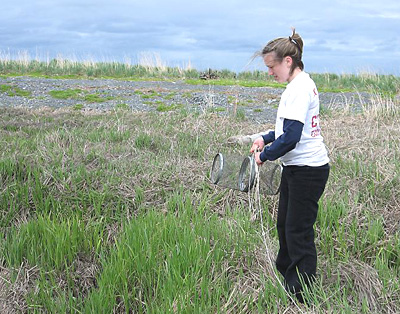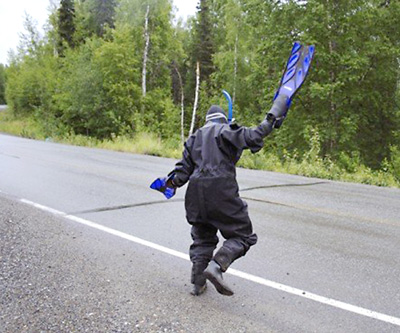Karyn Robert

My Master’s research involves examining the relationship between male stickleback aggression and color. Male stickleback develop brightly colored throats at key points in their lives (territorial, courtship, and parental stages). This red coloration is thought to play a role in both attracting mates and intimidating rivals. The red signal is widely thought to function in mate attraction. However, as it is displayed during the parental phase as well, it is likely to serve other functions. One possibility is that it serves a function in aggressive interactions, and it is this possibility that I am examining in my research.

I am currently running experiments on laboratory males from two Alaskan populations—one limnetic (parental fish from Lynne Lake) and one benthic (parental fish from Willow Lake). I am also running trials on hybrids from these populations. By showing nested males video images of males that have been artificially colored to display uniform red coloration, or no color, I am hoping to determine whether the red signal influences the response of the territory-holder to the apparent intruder. In addition I am exploring the possibility that benthic and limnetic populations respond differently to the red signal because these two ecotypes express the color differently.
How I got here:
As an undergrad, I had heard a lot about stickleback and the ongoing research that is conducted at Clark. In my junior year, I pursued my interest in the research and began working in the Foster-Baker laboratory. During that time I primarily helped in the fish room and learned about caring for the fish. The following summer, much of my time was spent running trials for grant research and assisting in the fish room.
In my senior year, I took the Animal Behavior course, and the laboratory ultimately served as a trial run for my Master’s work. The semester-long course project allowed me the time to practice different recording and testing techniques with the stickleback, on a smaller scale than that of my Master’s research. This project initiated my interest in my Master’s thesis topic.
In my senior year, I also worked on a paper with Susan Foster. It is currently in press in the journal Behaviour.
This past summer, I was invited to do field work in British Columbia and Alaska alongside some of my colleagues from the Foster-Baker lab. Although the water was a bit chilly despite the dry suit, it was by far the best experience I have had here at Clark.
What else:
During my undergrad years I was an active member of the Clark equestrian team and GLBTA, serving on the executive boards of both at various times. I also dabbled a bit in other on-campus groups. As a grad student, most of my free time is put towards research, working at a local veterinary clinic, and restoring my grandparents’ 1730s home.
Publication:
Foster, S. A., Shaw, K. A., Robert, K. L. & Baker, J. A. (In press). Benthic, limnetic and oceanic threespine stickleback: Profiles of reproductive behavior. Behaviour.
